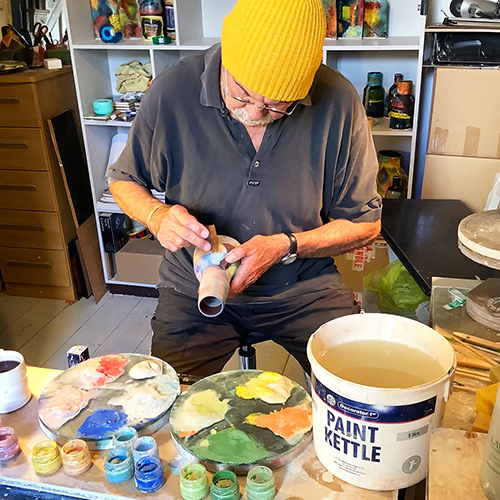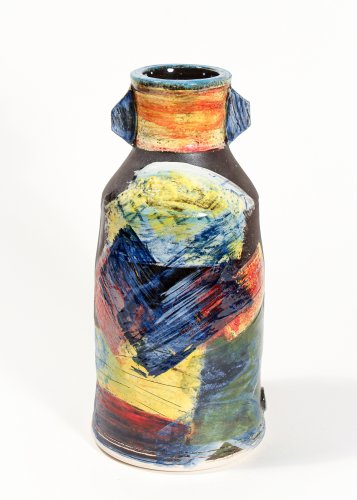John Pollex makes highly coloured earthenware pots with expressive abstract markings. He established himself in the 70s and 80s as a respected maker of traditional Slipware.


In 1981 he took part in a lecture tour of New Zealand with the contemporary American ceramist Don Reitz. The bold use of colour in the work of Reitz and other potters in the USA was exciting compared to the muted tones of celadons, tenmokus and honey glazes used in Britain. In 1984, referring to the work of painters such as Howard Hodgkin, Robert Natkin, Patrick Heron and Ben Nicholson, he developed a new style of work. Using brushes and spatulas, intensely coloured earthenware slips are freely applied in a painterly abstract manner onto highly individual thrown and altered pots. The images often reflect his interest in Eastern meditative philosophies. He sees his work in the area of three dimensional painting, whereby clay substitutes canvas.
Pollex's work often includes references to Zen Buddhism, in particular the immediacy of brush strokes in Zen calligraphy. Music too, plays an important part in the activity of painting a pot, helping create an atmosphere to reflect feeling and mood. His preference generally falls into two categories which he thinks of as inner and outer. The inner being more contemplative, which might include Gregorian chants, Indian music and the timelessness of the Shakuhachi from Japan. The outer would cover anything from modern jazz to opera.
John Pollex studied at Sir John Cass in Whitechapel from 1966-68 and was Technician at Harrow College of Art from 1968-70. After Harrow he became assistant to Colin Pearson until 1971. He moved to Plymouth in the autumn of 1971. He has exhibited widely through out the UK and in London, Spain, New Zealand and the USA. His work has been featured on television and in numerous publications.
Selected Exhibitions
Bircham Gallery
Rufford Craft Centre, Notts
Woodbury Studio Gallery, Devon
Bettles Gallery, Hampshire
The Gallery at Bevere, Worcs
Broughton Gallery, Scotland